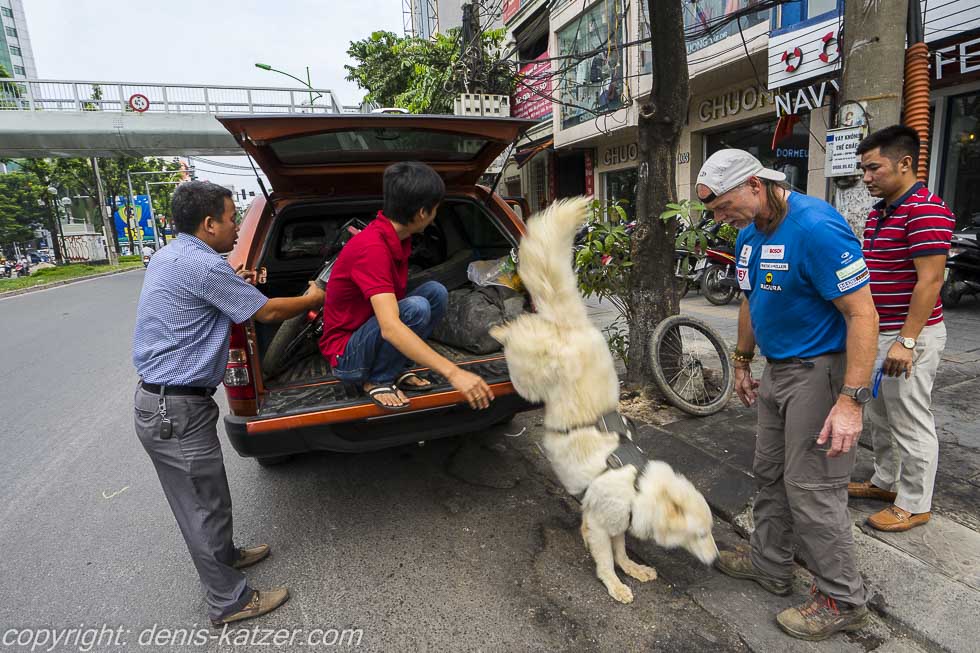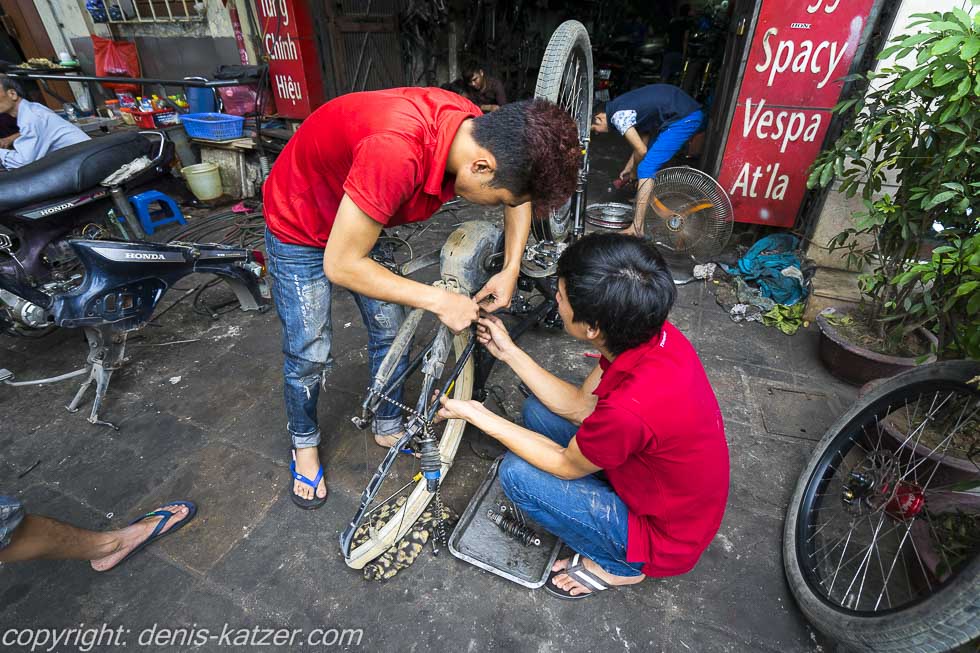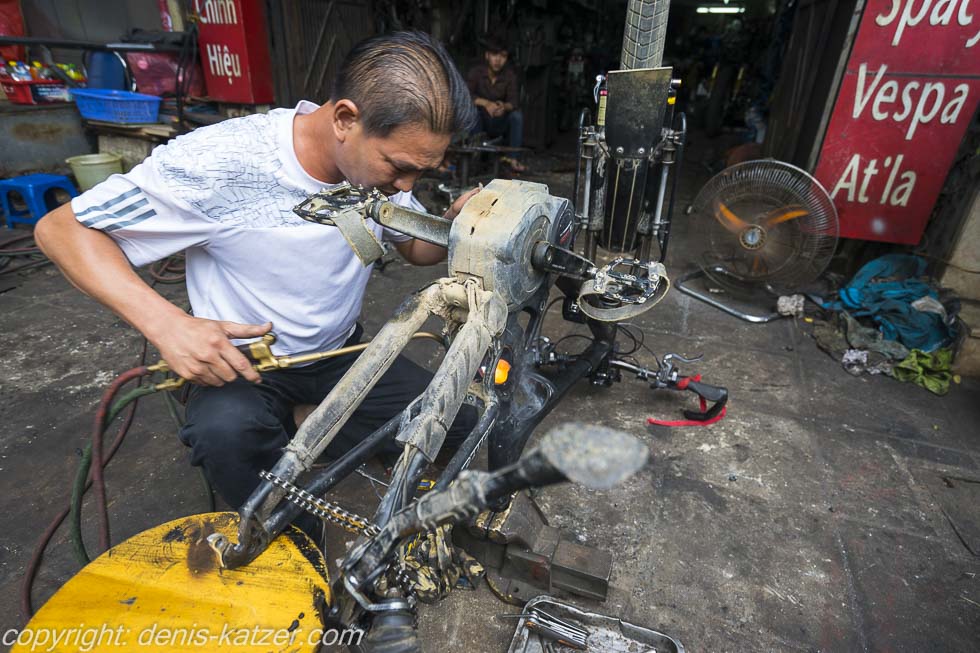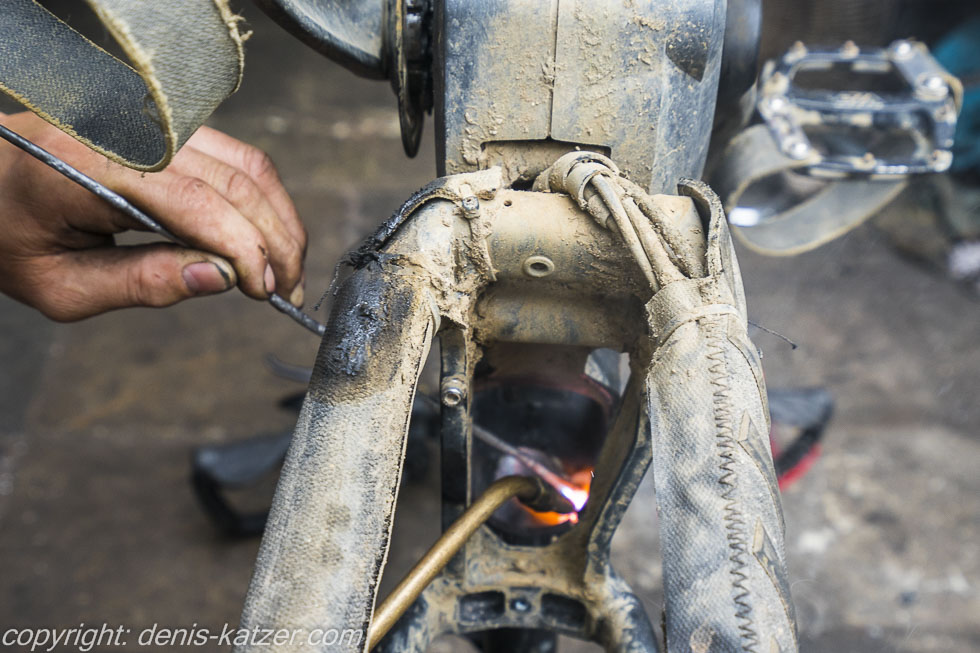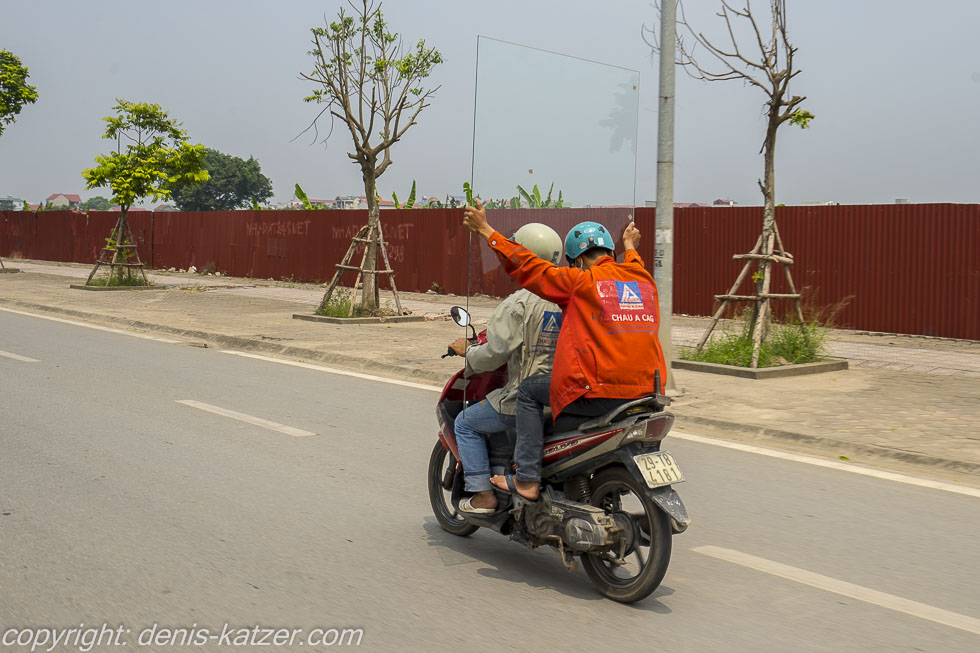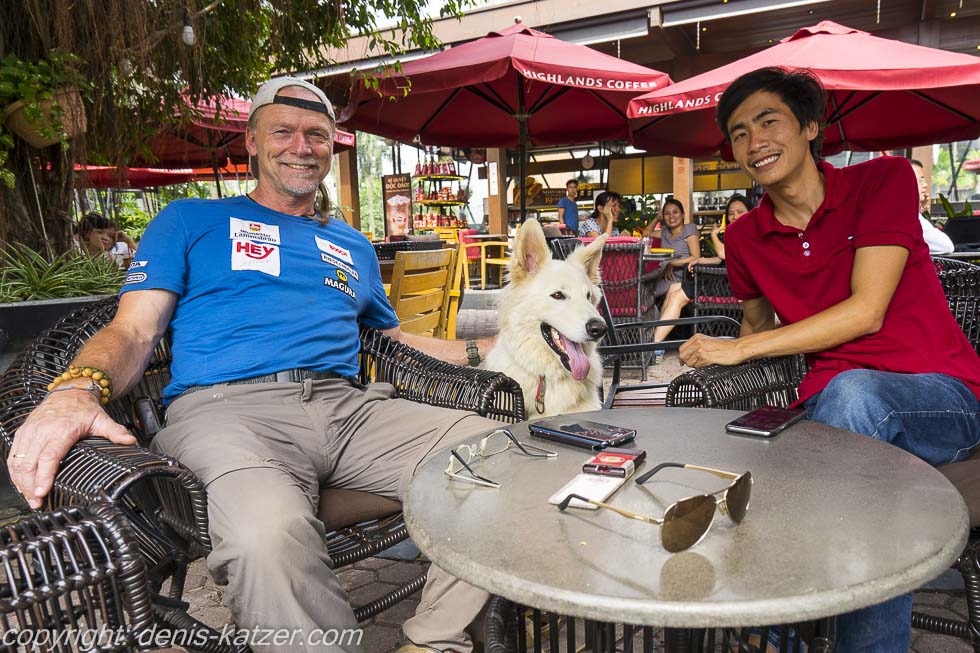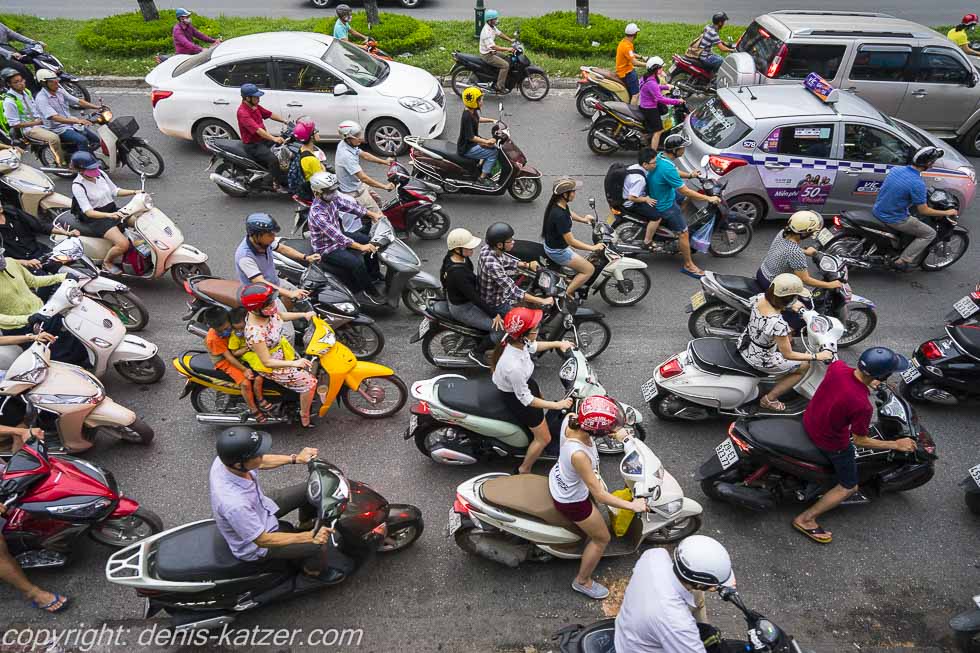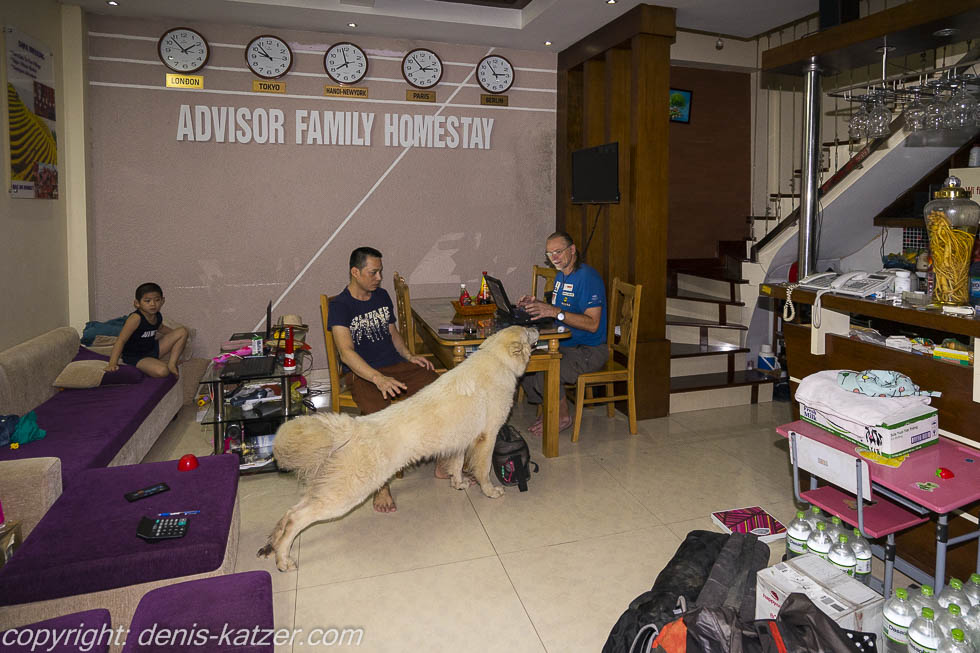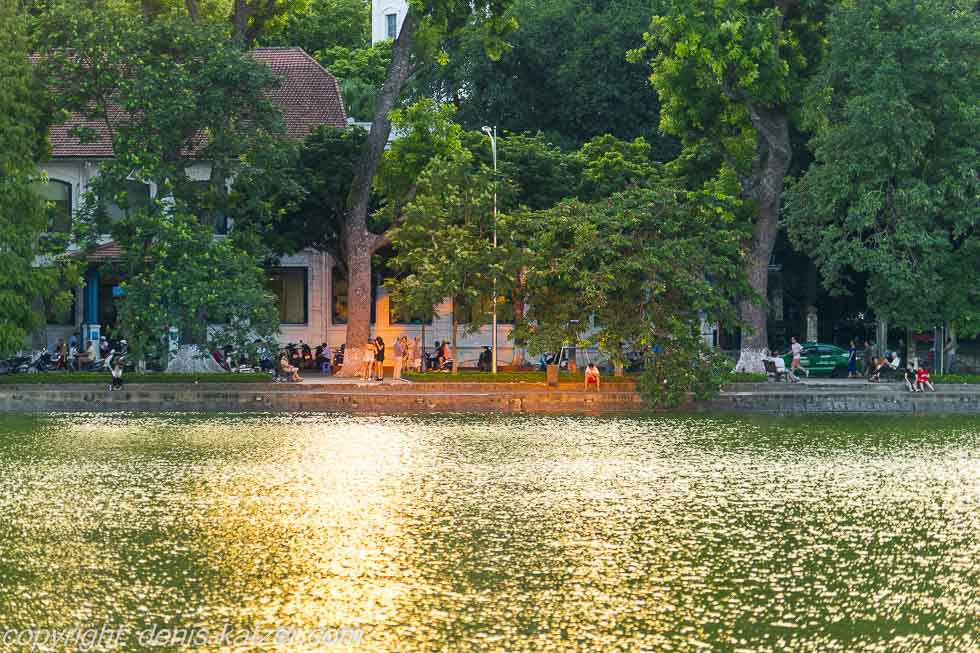
The aluminum welder – The oldest capital of Southeast Asia – Rich and powerful
N 21°02'09.5' E 105°53'01.1''
Date:
23.09.2016
Day: 455
Country:
Vietnam
Region:
Delta of the Red River
Location:
Hanoi
Latitude N:
21°02’09.5”
Longitude E:
105°53’01.1”
Daily kilometers:
Covered 150 km by car
Total kilometers:
18,646 km
Maximum height:
1.100 m
Total altitude meters:
54.661 m
Sunrise:
05:45
Sunset:
5:53 pm
Temperature day max:
37°C
Temperature day min:
26°C
(Photos of the diary entry can be found at the end of the text).
After stowing the bike and Ajaci in Manh’s jeep, we leave Mai Chau in the direction of Hanoi. We cross the pass that Tanja talked about and which we want to avoid on our next departure because of its gradient. “And the homestay in Hanoi doesn’t mind if we bring Ajaci with us?” I ask Manh again, “No, you and your dog are welcome. I’ve contacted 1,200 hotels via Facebook. At least 10 or 15 hotels and homestays have replied and would accept you with your dog.” “Fantastic. Thank you so much for your commitment,” I say as we have just reached the highest point of the pass. “If the aluminum welder fixes my bike, everything will be fine again. Then we can finally continue our journey,” I say, looking at the mountain landscape flying past the window. “I’m sure he’ll do a good job. Hung knows a lot of people in the city. He has very good contacts everywhere. If he says the man can weld, then he can. You can rely on that,” replies Manh. Although I trust Manh, I’m still skeptical. I’ve already experienced too much during our travels. “What’s it actually like on Vietnamese buses? Can you take a dog with you?” I ask, because we want to use our stay in Hanoi to make a detour to the Halon Bay World Heritage Site. “No, dogs aren’t allowed there,” Manh’s answer startles me. “And how are we supposed to get to Halong Bay then?” “Hm, I could call my ex-boss. You know, he’s the man who hired me many years ago and gave me the opportunity to leave my poverty.” “And how can he help us?” “He owns several minibuses, two excursion boats and a resort on Monkey Island. Maybe I can organize a boat trip through Halong Bay and a few nights on Monkey Island for you? I’ll tell him how lovely your Ajaci is. Maybe I can convince him. If so, you’ll be picked up directly from your homestay in a minibus. Then Ajaci can come on the boat and join you on the private island.” “Well, that sounds too good to be true.” “Should I call him? Would you like to?” Tanja and I look at each other and agree. “Sure, please call him,” I say euphorically. “Your friends are welcome at my place. You and your dog can stay as long as you like. You’ll get my best bungalow,” says the Manhs ex-boss on the phone. “Unbelievable. That’s really great. And how much does it cost?” “Your friends are like your family to me. They don’t have to worry about the cost,” we hear and can hardly believe our luck. “I told you my ex-boss is a fine man. He treats you just as if I were coming in person. He’s been a good friend of mine for a long time. Just last year, he spent two days with his family at my resort. We help each other out.” “Great, then the Hanoi trip is turning into an exquisite excursion,” I say enthusiastically. “Yes, you always say yourself that everything that happens has a purpose. At least the frame break will take you to Halong Bay and Monkey Island in a very pleasant way,” Manh says with a laugh.
“Are we actually in Hanoi yet?” I ask, because we’ve been driving past countless houses and buildings on busy roads for ages. “It used to be a separate province, Ha Tay, but in 2008, some provinces and provincial districts were added to the administrative area of Hanoi.
The city now consists of 29 districts and its area has tripled. As far as I know, our capital Hanoi is now one of the largest metropolitan areas in the world.” “And how many inhabitants does Hanoi have today?” “Around 7.6 million.” “It’s a bit of a traffic mess,” I say as we weave our way through the piles of metal and mopeds.” “You should experience rush hour. In comparison, this is comparable to a peaceful climatic health resort,” replies Manh. “Hm, I hope we’re spared that,” I reply as a moped overtakes us, its driver waving wildly at us. Manh rolls down the window. Immediately, humid, muggy air pours into the passenger compartment. The moped driver and Manh exchange a few cheerful sentences while driving, then the window whirs up again and the air conditioning kicks into high gear to drive the blistering heat out of the car. “That was my friend. I’ve known him for a long time. His family is very influential. What a coincidence to meet him just now. He knows every corner of Hanoi and will take us to the welder we’re looking for.”
Manh parks his car in a no-parking zone at the side of the road. We quickly unload my bike and roll it to the workshop. We explain to a mechanic what needs to be done and show him the frame crack. He examines the break with a skeptical look. I wonder if he can’t weld them after all. I am secretly praying for a good outcome to the repair and that our journey can continue. “And what does it look like? Is he going to weld the frame?” I ask a little nervously, because I don’t want to hear a negative answer. “He will,” Manh replies with a smile. “I told him that you’re on a world tour with a lot of luggage and the job has to be done carefully. That’s why the boss will personally weld your frame.” “Manh, you’re a sweetheart,” I say happily. Before I know it, two mechanics are dismantling my bike. I follow their every move with suspicious eyes, because it’s no good for me if they take the rear end apart and possibly can’t reassemble it. I immediately collect the screws that fall onto the oily floor and put them in a bowl. After everything has been dismantled, I tell the mechanics not to burn the cables leading to the rear light and from the engine to the display when welding. “No problem,” they say. One of the most dangerous statements in Asia because, in my experience, this is where the problems usually start. Gia Son, the head of the workshop, now shuffles over with the welding machine and begins to weld the break first from the inside and then from the outside. The work is completed just 10 minutes later. “They want to repaint the frame area at the weld seam. I think it makes sense if I take you to your accommodation in the meantime and we come back later,” Manh suggests. “Okay,” I say, hoping that the mechanics will put everything back together properly.
An hour later, Manh and I drive back to the workshop. It’s 5:30 pm and so we’re in the middle of the infamous rush hour. We only make progress at walking pace, if at all. The traffic is apocalyptic, insane, impossible to describe in words. I’ve seen a lot in this world, but the man-made, stinking, heaving, monster metal ball in Hanoi is a nightmare. Suddenly we are standing in the middle of the intersection. Nothing works anymore. No back and no forth. Hundreds of mopeds squeeze past Manh’s jeep at centimeter intervals. Some drivers even lean on the bodywork of our car with their hands during the constant standstill. “What an overwhelming mess,” I gasp. Tuuuhhhht! It roars behind us. You could be forgiven for thinking that the rear window is pressing into the passenger compartment. A truck is apparently trying to blow a path through the thicket of bodies, rubber and sheet metal with the pressure wave of its oversized horn. Without success. Tuuuhhht! Tuuuhhht! Tuuuhhht! It answers from all sides. What must it have looked like here in 1010, when today’s oldest surviving capital of Southeast Asia was founded and became the capital of the Kingdom of Đại Việt? Or what was it like in the citadel of Cổ Loa, just a few kilometers from here, which reached its peak during the Bronze Age. It was the time of the early Vietnamese kingdom of Âu Lạc. I would love to travel back in time to see how people lived in this region back then. It was certainly quieter at that time than it is now and the air was still clean and clear, without any pollutants. Tuuuhhht! Tuuuhhht! Tuuuhhht! It takes me back to the present of Hanoi, a city that was repeatedly conquered by invaders during its lifetime, renamed again and again, and lost its function as the capital. If the city were a living creature, it could certainly tell a lot about its suffering. Only from the time in 1873 when it was conquered by the French. Or from the years 1883 to 1945, when it was the administrative center of the French Indochina colony, during which the French destroyed the imperial palace, the old citadel and large parts of the city south of the center in order to build perpendicular avenues with opera houses, churches, public buildings and luxury villas. Tuuuhhht! Tuuuhhht! Tuuuhhht! The terrible sound of the loud horns repeatedly maltreats our ears. Startled, I look out of the side window directly into the glaring headlights of a bus that comes to a halt just a few centimetres in front of us with screeching brakes. It’s almost like war and I remember that between 1946 and 1954 this city was the scene of fierce fighting between the French and the Viet Minh. Somehow it seems to me that the huge city of Hanoi will never be able to recover properly, because as soon as the French were driven out, the Americans let the city sink in a hail of bombs from 1960 to 1972. In 1972 alone, 25 percent of Hanoi was destroyed by 40,000 tons of explosives.
“I don’t think it was a good idea to leave the welder,” I interrupt my thoughts, as it takes us over an hour to cover the eight kilometers from our accommodation to the workshop. Despite the slow progress, time passes quickly. We have a lively conversation. I tell Manh about our plan to cover part of the next stage of our e-bike expedition, which we want to start in 2019, on an elephant. “With an elephant? That sounds crazy.” “Yes, we want to draw attention to the threatening situation of the pachyderms in Asia and Africa.” “That’s a fantastic idea. I love elephants. In which country were you thinking of doing the elephant trip?” “Maybe in Myanmar, Laos or Cambodia. There are still elephants there that would make such a trip possible.” “And why not in Vietnam?” “Do you still have elephants?” “Of course we do. Down south on the border with Cambodia. There are some national parks where wild elephants still live. In Dak Lak province, for example, they even organize an elephant race every year. Unfortunately, the population of our Vietnamese elephants is in extreme decline and threatened with extinction.” “Unfortunately, this is the case worldwide. Maybe we’ll get the chance to visit one or two national parks on our trip to the south of the country. And who knows, maybe we can find out something about elephants? If that’s the case and we can make some serious contacts, we’ll see you again on our next leg of the journey.” “Well, that would be great.” “Yes, that would be really nice. That gives me an idea. Hung is a filmmaker, isn’t he?” “So what?” “We could make a movie about the elephant expedition. We could use it to raise awareness of the issue among many people in Vietnam.” “Denis, that’s a great idea. I’ll talk to Hung and Hai about it. If they get involved, you might really have a chance of getting an elephant. They’re both very influential,” he says when we arrive at the workshop. My bike is standing in front of the entrance with a newly painted weld seam and fully assembled. “Fantastic,” I say, shake the moped workshop boss’s hand with thanks and pay him 400,000 dong (€16) for the entire repair.
Because Manh has to go to Sa Pa for a few days and is leaving his car in Hanoi, we bring my bike to Hai’s house. Hai is the senior official of the Ministry of Finance of Vietnam, which owns 50 percent of Nature Lodge. When Manh returns from Sa Pa, he will stop by Hai to load my bike back into his car and drive it to Mai Chau. “Here we are,” says Manh, pointing to a modern five-storey building. “And which floor does Hai live on?” I ask. “In the whole house.” “How in the whole house?” I wonder, as it’s a house in which at least five, maybe even 10 families can live comfortably. “Well, the whole house.” “You mean he lives in this house from the ground floor up to the fifth floor? How big is his family?” “He has two children and a wife.” “I can’t believe it.” “Oh yes, and a couple of service floors.” “Sure, you need a squadron of people just for cleaning,” I reply, still stunned. “They must be really fit if you have to walk from the ground floor to the fifth floor.” “Nobody has to walk. They have an elevator.” “Sure, why not. Everyone needs their own elevator in their house,” I joke. “As a senior civil servant in the Ministry of Finance, he must earn a lot of money.” “He’s not just a senior civil servant, he’s the boss,” Manh corrects me. “The boss? From the city of Hanoi?” “No, from Vietnam.” “From the whole country?” “Yes.” “Then nothing surprises me anymore.” “Hai is very, very rich. He owns many houses. He’s also a good and devout Buddhist. Just a few months ago, he donated a house worth 1.5 million dollars to a Buddhist temple.” “US$1.5 million?” I ask, because I think I’ve misheard him. “Yes.” “You’ve picked yourself a powerful business partner.” “To be honest, Hung and Hai chose me because they wanted to invest in a resort. They came across my Nature Lodge through contacts. I didn’t actually want to sell any shares. But after many discussions and offers, I couldn’t turn them down,” he explains and rings the doorbell. It doesn’t take long for a servant to open a large door for us. Because Hai is away on business, we don’t meet him. We carry my bike to the ground floor and say goodbye to the woman again…
If you would like to find out more about our adventures, you can find our books under this link.
The live coverage is supported by the companies Gesat GmbH: www.gesat.com and roda computer GmbH http://roda-computer.com/ The satellite telephone Explorer 300 from Gesat and the rugged notebook Pegasus RP9 from Roda are the pillars of the transmission. Pegasus RP9 from Roda are the pillars of the transmission.
